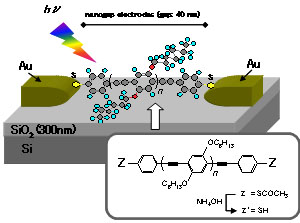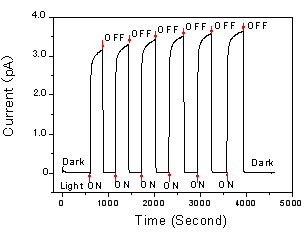Hiroshi Nakashima, Wenping Hu, Kazuaki Furukawa, Yoshiaki Kashimura, Katsuhiro
Ajito
and Keiichi Torimitsu
Materials Science Laboratory
Å@Molecular-scale device, comprising single or small number
of organic molecules, has experienced extensive attention and rapid development
recently. Bottom-up process using organic molecules enables us to fabricate
high-dense and fine-tuned devices due to the advantages in size and design
of the molecules. Conjugated polymers exhibit remarkable carrier transport
and photo absorption/emission properties based on electrically conjugated
polymer chain, and are thus expected to apply nano-scale electronic and photonic
device components. Recently, we have synthesized a rigid π -conjugated
poly(p-phenylene-ethynylene) derivative including thiol end groups
(TA-PPE, Fig.1) [1]. By utilizing a selective chemisorption property of thiol
end groups onto Au surface, it is possible to fabricate a self-assembled TA-PPE
nanojunction between Au nanogap electrodes, Au/TA-PPE/Au (gapÅ`40 nm). We successfully
observed a remarkable photocurrent switching behavior of the nanojunction
[2].
Å@Figure 2 shows the photocurrent response behavior of the nanojunction under
light irradiation. With light on or off, the nanojunction exhibits switching
between a low-current state in dark conditions and a high-current state in
light conditions as a nanometer-scale photoswitch (the voltage between two
nanoelectrodes is kept constant at 0.5 V). In the ÅgoffÅh state, the resistance
is as high as Å`1015Ω. In the ÅgonÅh state, the resistance is
Å`1012Ω, the switching ratio is as high as 1000. The switching
in those two states is reversible and fast. Under illumination, the photon-generated
excitons are dissociated into free electrons and holes, some of them possessing
sufficient energy to jump over or tunnel through the Au-S barrier, resulting
in high current (ÅgonÅh state) of the nanojunction. In addition, with intensity
of the incident light changing, the current of the nanojunction device changed,
exhibiting significant light intensity dependence. This phenomenon is understandable
in terms of the changing of photon density in the incident light.
Å@In the future, we are aiming at the fabrication of novel molecular-scale
composite devices integrating the nanojunction with other optoelectrically
functionalized organic/bio molecules.
[1] H. Nakashima, et al., Langmuir 21 (2005) 511.
[2] W. Hu, et al., J. Am. Chem. Soc. 127 (2005) 2804.
 |
 |
|
| Fig. 1. Molecular structure of TA-PPE and nanodevice structure | Fig. 2. Photoresponse characteristics of the nanojunction device (white light, 52 mW) |